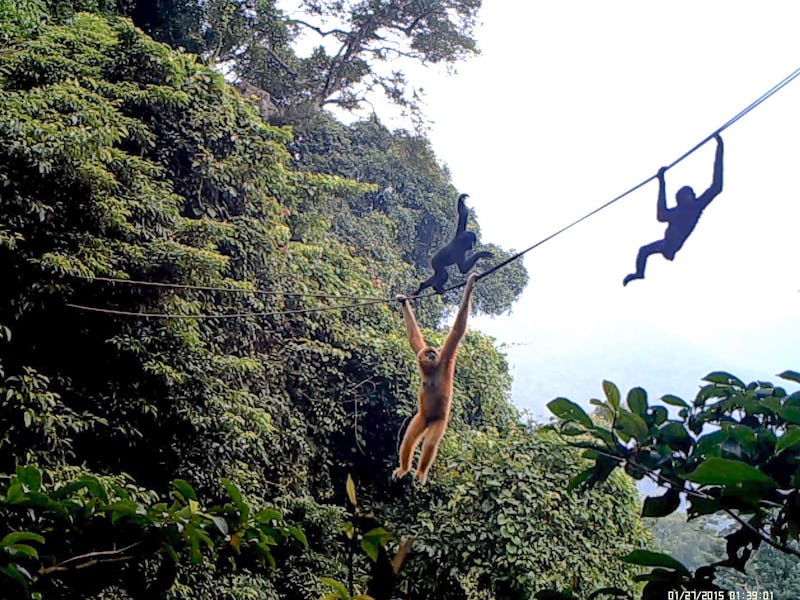Humans are trying everything to make the wild livable for animals, again
After messing the Earth up, humans are trying to give wild animals a fighting chance.

Nature is in crisis. According to the United Nations, from 2015 through 2020 the rate of deforestation was estimated at 10 million hectares, 38,610 square miles, per year. That amounts to a little over 193,000 square miles of forest destroyed in five years, larger than the entire state of California.
That destruction, mostly in the name of agriculture, has wreaked havoc on animal habitats. As the UN’s “State of the World’s Forest” 2020 report notes, it is not just trees that make up forests, “but the many different species of plants and animals” as well.
But we humans can use our greatest asset — the ability to innovate — to try to tackle the problem we have created. And one of the most promising ways to do this may be to re-engineer the wild.
These three inventions show that, by both recreating and improving upon nature within human-affected habitats, humans could make the natural world more livable for the animals within it.
Creative canopies
A recent study published in Scientific Reports details how scientists are trying to stitch fragmented forests back together. Using a series of artificial canopy bridges, scientists in China tried to solve the problem humanity created, reconnecting areas of disfigured and fragmented forests for the Hainan gibbon monkeys who live in the area.
While not perfect, the bridges may be a “useful short-term solution” for helping animals in the wild, according to the study.
To create the bridges, the Chinese team used “mountaineering-grade ropes” that were tied to sturdy trees. After 176 days of checking the ropes out, the gibbons seemed to get over their skepticism and start using them.
A professional tree climber building the artificial canopy in 2015.
The scientists noted the gibbons showed "signs of hesitation," especially among adult females and small juveniles. That hesitation seemingly wasn't shared by adult males, who just used their body strength to simply leap the distances that the bridges were meant to cross.
But over time, the gibbons seemed to get the hang of it. The scientists found a “gradual increase in bridge use frequency” from 2016 through 2019.
Gibbons using the artificial canopy system. Pictured are a female and young gibbon.
Stepping stones
Another example of how this strategy could work comes in the form of some rather cute, tree-climbing crabs.
A 2019 study published in PLOS looked at how climate change could force the creation of ”stepping stone refuges” for mangrove tree crabs, which live in semitropical environments like eastern Florida and northern Brazil.
Mangrove tree crabs generally live, you guessed it, on and around mangrove trees. These trees are threatened by climate change's effects, from sea level rise to the sediment dredged up during hurricanes. At times, mangrove tree crabs may move from the unstable mangrove environment and into salt marshes. Within these salt marshes, researchers have hit on a potential low-tech refuge for the crabs: wooden docks, the types built for small boats.
A mangrove tree crab.
By “providing conditions more similar to the mangrove than the surrounding colonized ecosystem, docks act as both a mangrove analogue and a refuge habitat... within the suboptimal novel ecosystem of the salt marsh,” the scientists write.
One thread that ties many artificial structures together is their relatively low-tech nature. Animals in the wild need consistency more than anything else, so any built solutions must be created with repeated use in mind.
Salmon cannon
Seattle-based company Whooshh specializes in that sort of repeated use. The company focuses on fish passage — essentially the task of getting fish from Point A to Point B. Various fish species migrate, including salmon. But human development can fatally interrupt this essential process. That's where Whooshh's "salmon cannons" come in.
These systems basically shoot fish (not just salmon) over dams and other man-made structures to enable them to continue on their migratory journeys. The cannons have been recognized as a useful system by the United States Department of Energy, which noted in 2016 that their “salmon cannons” can give fish a “boost over dams so they can swim upstream to spawn.”
The Whooshh system, known more accurately as the PassagePortal, combines other technology that benefits researchers, too. Using its FishL Recognition system, the Portals take eighteen high definition images of every fish that enters from three different directions, capturing data on everything from species to fin length.
Survive and thrive — While these three strategies are helping wild animals reclaim their spaces, these systems are not replacements for natural systems, which are far and away the best fit for animals who have spent thousands of years evolving to match their surroundings.
But given the damage currently being across the globe, they could offer animals a chance to adapt to the changing world.
This article was originally published on